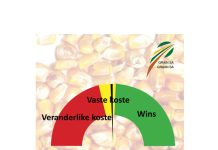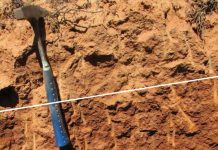



Scientific name: Eleusine corocana
Afrikaans name: Jongosgras, osgras
English name: Goose grass, rapoko grass
Short description
Goose grass is an annual tufted grass, growing up to 60 cm high. The grass has a strong and well developed root system. A characteristic of this weed is its powerful initial root development, which makes it so well adapted to the climate in southern Africa. Culms are often branched and kneed at the base and hairless. Leaves are up to 50 cm long and 1 cm wide, hairless and distinctively folded. Inflorescence is vivid light green and consists of two to ten one-sided spikes, arranged finger-shaped (dactylose) or half finger-shaped. Spikelets usually cross over each other and are also characteristically flat. Seeds (caryopses) are black, oval-shaped, up to 2 mm long and 1 mm wide. The surface is sharply ridged along the sides, across the whole seed.
Distribution
Goose grass is the most common grass weed of cultivated fields in South Africa. Because of the extended and vigorous root system, it is one of the most severe competitors with dryland summer crops. Most of the grass weed species’ seedlings look very much alike and it is sometimes difficult to distinguish between finger grass (Digitaria spp.), herringbone grass (Urochloa spp.), buffalo grass (Panicum spp.) and goose grass.
Control
Cultivation
Goose grass can be controlled by means of shallow cultivation in the seedling stage. Shallow cultivation will bring fresh seed to the surface and cause them to germinate, which will require more cultivation (hoeing). However, goose grass will continue to germinate during the summer season and hoeing is not an efficient way of controlling it.
Chemically
The most efficient method of controlling grass weeds is by means of herbicides. Goose grass is one of the most susceptive grass species with regards to pre- and post-emergence herbicides. Grass herbicides give the most effective control and where heavy infestations occur, control should be as complete and timeous as possible.
Various herbicides are registered for the control of goose grass in maize and wheat (Table 1 and Table 2). Strictly follow the specific instructions and dosages on each product label.
TABLE 1: Herbicides registered for the control of goose grass in maize.
| Active ingredient | Formula | Time of application |
|---|---|---|
| acetochlor | 700 g/litre 750 g/litre 768 g/litre 840 g/litre 900 g/litre 960 g/litre | Pre-emergence or early post-(crop)emergence Early post-emergence of the crop, use as tank mixture with atrazine and/or terbuthylazine Pre-emergence Pre-emergence or early post-emergence, within three days after planting Early post-emergence, use as tank mixture with atrazine and/or terbuthylazine Read label instructions |
| acetochlor/atrazine/simazine | 160/165/165 g/litre | Apply at or immediately after planting on a well-prepared seedbed |
| acetochlor/atrazine/ terbuthylazine | 125/187,5/87,5 g/litre 150/225/225 g/litre 178,6/160,7/160,7 g/litre 250/225/225 g/litre 350/175/175 g/litre | Apply at or immediately after planting on a well-prepared seedbed Apply within three days after planting, but before crop and weed emergence Pre-emergence Pre-emergence or early post-emergence, Apply at, or immediately after planting on a well-prepared seedbed Pre-emergence or early post-emergence |
| acetochlor/EPTC | 150/350 g/litre | Pre-emergence |
| alachlor | 384 g/litre 480 g/litre | At planting or immediately after, within two days after planting At planting or immediately after, within two days after planting |
| alachlor/atrazine | 336/144 g/litre | Pre-emergence on a well-prepared seedbed within two days after planting |
| atrazine/mesotrione/ s-metolachlor | 208,5/26,8/208,5 g/litre | Pre-emergence |
| atrazine/metazachlor/terbuthylazine | 210/30/210 g/litre | Pre-emergence, within three days after planting Post-emergence as follow-up application |
| atrazine/metolachlor | 300/300 g/litre | Pre-emergence, within three days of seedbed preparation and planting |
| atrazine/metolachlor/terbuthylazine | 174/252/174 g/litre 262,5/175/262,5 g/litre | Pre-emergence or early post-emergence Pre-emergence or early post-emergence |
| atrazine/s-metolachlor | 370/290 g/litre | Pre-emergence, apply at/or immediately after planting on a well-prepared seedbed |
| dimethenamid-P | 720 g/litre | Pre-emergence, apply within three days of planting |
| dicamba/topramezone | 160/50 g/litre | Early post-emergence, before six leaf stage, use in tank mix with atrazine or atrazine/terbuthylazine and Dash HC |
| EPTC | 720 g/litre | Pre-plant, incorporate into soil, read the label |
| flumetsulam | 800 g/kg | Pre-emergence, use only in tank mix with metolachlor or S-metolachlor |
| flumetsulam/s-metolachlor | 20/630 g/litre | At planting on a well-prepared seedbed within three days after planting |
| glyphosate/mesotrione/ s-metolachlor | 250/25/250 g/litre | Post-emergence, only on glyphosate resistant cultivars |
| mesotrione/s-metolachlor | 83,3/416,7 g/litre | Pre-emergence |
| metolachlor | 800 g/litre 840 g/litre 915 g/litre 960 g/litre | Pre-emergence on a well-prepared seedbed, within three days after planting Pre-emergence, on a well-prepared seedbed, within three days after planting Pre-emergence, apply on well-prepared seedbed, within three days after planting Pre-emergence, apply on well-prepared seedbed, within three days after planting |
| metribuzin | 480 g/litre | Post-emergence, apply on actively growing weeds after they have emerged to the four to six leaf stage |
| nicosulfuron | 40 g/litre 240 g/litre | Post-emergence, when crop is in two to six leaf stage |
| topramezone | 226 g/litre | Early post-emergence. Read label instructions |
| s-metolachlor | 915 g/litre 960 g/litre | Pre-emergence on a well-prepared seedbed, within three days after planting Pre-emergence, read label instructions |
| s-metolachlor/terbuthylazine | 102,8/497,2 g/litre 312,5/187,5 g/litre | Pre-emergence, on a well-prepared seedbed Early post-emergence, only to be used in a tank mix with Callisto |
TABLE 2: Herbicides registered for the control of goose grass in wheat.
| Active ingredient | Formula | Time of application |
|---|---|---|
| trifluralin | 480 g/litre | Pre-plant, dosage depends on weed species |
Always contact a reliable chemical advisor before applying any chemicals to ensure the correct dosage and specifications are adhered to.
Contact the writers at elbe.hugo@syngenta.com (Elbe Hugo) and deweth@arc.agric.za (Hestia Nienaber).

















